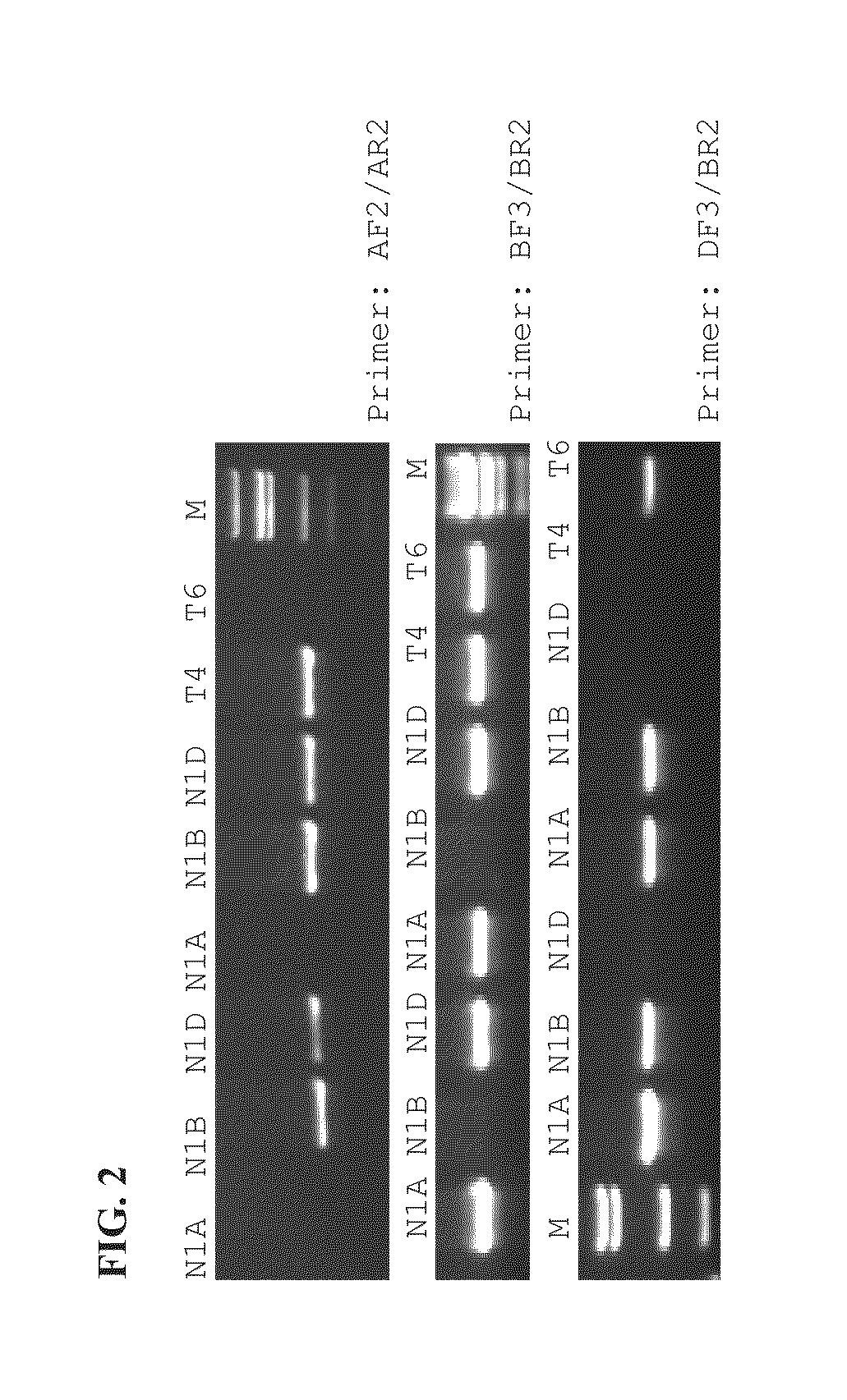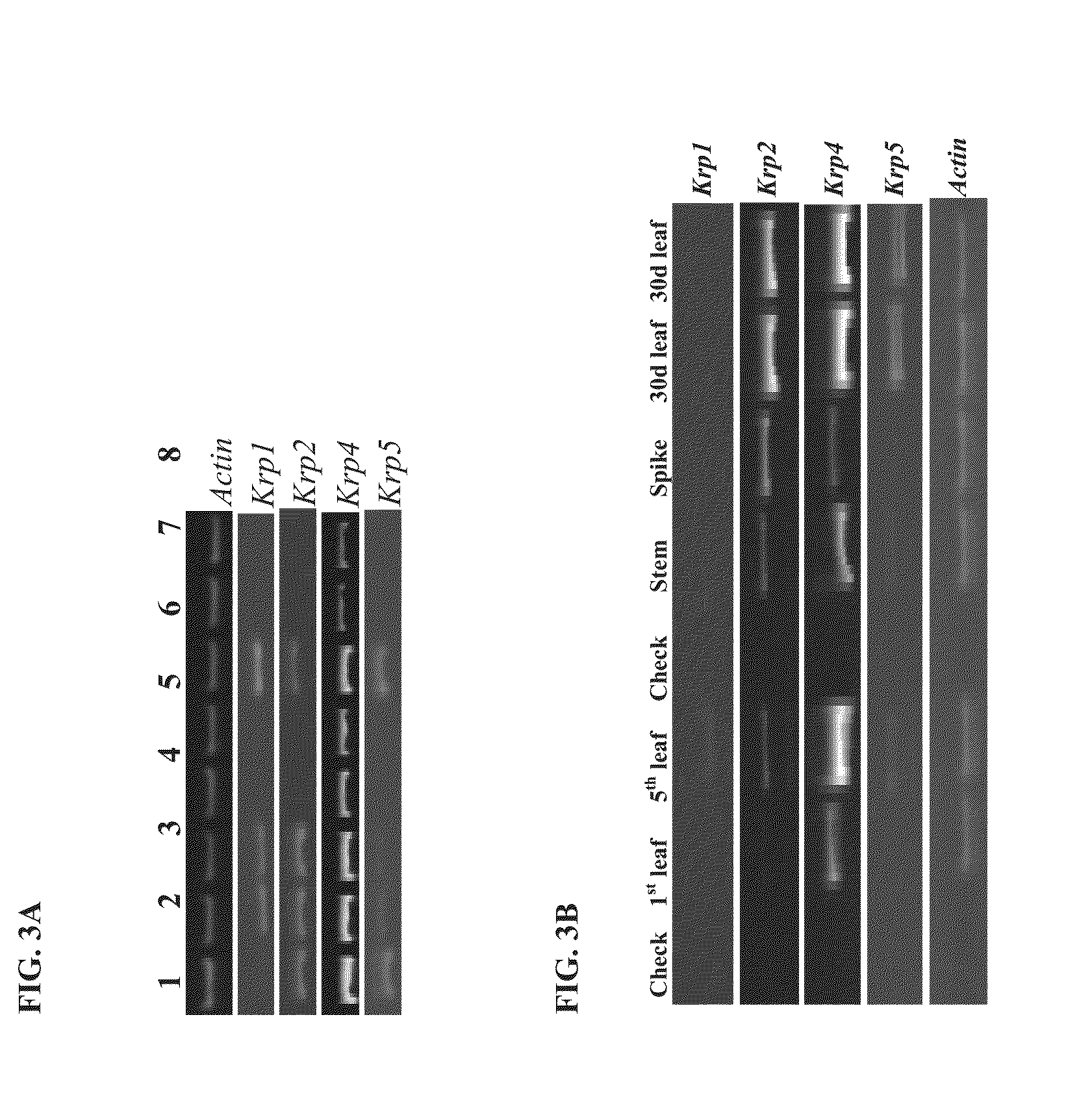Identification and use of krp mutants in wheat
a technology of krp mutants and compositions, applied in the field of identification and use of krp mutants in wheat, can solve the problems of not fundamentally improving crop yield, becoming smaller, and more difficult to obtain, and achieves the effects of improving agronomic and horticultural characteristics, increasing seed size, increasing seed number, and increasing weigh
- Summary
- Abstract
- Description
- Claims
- Application Information
AI Technical Summary
Benefits of technology
Problems solved by technology
Method used
Image
Examples
example 1
Identification of KRP Homologues from Wheat
[0208]The inventors used available EST collections and proprietary sequences to generate partial predicted proteins for the different wheat KRP genes (SEQ ID Nos 1-5).
[0209]A multiple sequence analysis was generated using the protein sequences for rice, maize, and wheat KRP genes. Alignment of sequences was done by using online Multiple Sequence Alignment (MSA) service provided by European Bioinformatics Institute and the bootstrap values were calculated by using online software TreeTop-Phylogenetic Tree Prediction provided by Moscow State University (FIG. 1). Values in the branches in FIG. 1 are bootstrap values.
[0210]Based on our phylogenetic tree construction, we discerned a correspondence between the wheat, rice, and maize KRP genes. The relationships we figured out between the different KRP genes appear similar to the one reported by Barroco et al. (2006), The cyclin-dependent kinase inhibitor Orysa; KRP1 plays an important role in see...
example 2
Genome-Specific Primers for TILLING® of Wheat KRPs
[0213]The genome specificity of the wheat KRP primers using Chinese-Spring (CS) nulli-tetrasomic lines and TILLING® cultivars were validated. The validation for wheat KRP4 primers is shown in FIG. 2. Table 1 lists the TILLING® primer sets for each wheat KRP.
TABLE 1TILLING ® primers for wheat KRPsSEQ IDGene / GenomePrimer namePrimer sequence (5′ to 3′)NOKRP1AKrp-A1_AF1GTCTGTAGAACGGCGTTACG6Krp-A1_R8CCCCAGCTCTACAGTGAGTAACTT7KRP1BKrp-B1_F5GGAGAGAATCCAAAGAGCAAC8Krp-B1_R7CCAGCTCTACAGTGAGTAAC9KRP1DKrp-D1_F4CGTGTTATATGTGTACGCACAC10Krp-D1_DR2GGCTATAATGCTTCTTTCTGGAGC11KRP2AKrp-A2_BF3CAAACGGCCAAAGCGACGG12Krp-A2_AR3CTAGTGTTGCATAGTTAGCTC13KRP2BKrp-B2_BF3CAAACGGCCAAAGCGACGG14Krp-B2_BR2TCTCGCCTCCGAGTCTAAGT15KRP2DKrp-D2_BF3CAAACGGCCAAAGCGACGG16Krp-D2_DR1CAGATTTGAACAAGGTGGATC17KRP4A_exon1WKP4_AFITACCCGCGCCTCGCTTAAATCCGCCAAA18WKP4_AR1GTCAACTCGTGAAAGAAGAGTTGGGACAGA19KRP4A_exons 2-3WKP4_AF2CCTTAGGCAAGTTCGGTAAGAAATGTGTA20WKP4_AR2GTGGTCATTACAGAATGAGTTGCTAAC...
example 3
Discovery of a Natural KRP-A4 Deletion in Hexaploid Wheat
[0214]Both sets of A genome KRP4 primers did not amplify the KRP4 gene in the hexaploid TILLING® line (FIG. 2), suggesting a possible natural deletion in the KRP4 A genome of the hexaploid TILLING® line. This was confirmed with the use of 3 gene-specific primers.
[0215]The B and D copies of KRP4 in hexaploid wheat were TILL'ed. The hexaploid mutations can easily be moved between tetraploid and hexaploid wheat by crosses.
PUM
 Login to View More
Login to View More Abstract
Description
Claims
Application Information
 Login to View More
Login to View More - R&D
- Intellectual Property
- Life Sciences
- Materials
- Tech Scout
- Unparalleled Data Quality
- Higher Quality Content
- 60% Fewer Hallucinations
Browse by: Latest US Patents, China's latest patents, Technical Efficacy Thesaurus, Application Domain, Technology Topic, Popular Technical Reports.
© 2025 PatSnap. All rights reserved.Legal|Privacy policy|Modern Slavery Act Transparency Statement|Sitemap|About US| Contact US: help@patsnap.com



